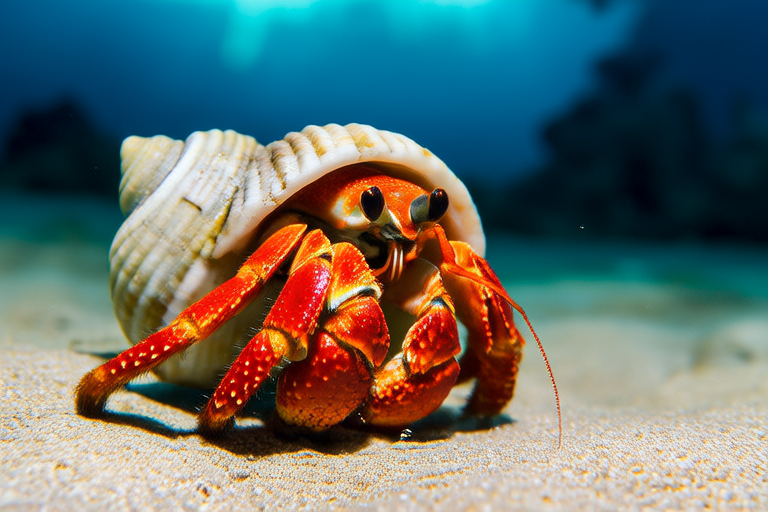The Unique World of Hermit Crabs: A Comprehensive Guide
Hermit crabs are among the most intriguing creatures in the animal kingdom, captivating both scientists and hobbyists alike with their unique lifestyle, habitat, behavior, and care requirements. These crustaceans have evolved an array of adaptations that allow them to thrive in diverse environments, from bustling beaches to serene aquariums. This article delves into the world of hermit crabs, exploring their shell-changing habits, social interactions, dietary needs, and sensory capabilities. Additionally, we will discuss recent studies on hermit crab communication and intelligence, offering valuable insights for those considering hermit crabs as pets.
Underwater Origins and Adaptation
Hermit crabs trace their origins back to the oceans, where they once roamed freely. Over time, some species adapted to life on land, but they still retain many aquatic traits. They require access to water for drinking and moistening their gills, which is why they must be provided with a shallow dish of dechlorinated water in their habitats. Despite their terrestrial adaptations, hermit crabs continue to breathe through gills, making it essential to maintain a humid environment for them. Their exoskeletons, while providing protection, also limit their growth, necessitating periodic shedding and molting.
Shell-Changing Habits
One of the most distinctive features of hermit crabs is their reliance on shells for protection. As they grow, hermit crabs outgrow their current shells and must find new ones to ensure their safety. This process is not only crucial for their survival but also serves as a fascinating display of resourcefulness. Hermit crabs exhibit a range of behaviors when searching for a new home, including inspecting potential shells, trying them on, and even engaging in shell fights with other crabs. The selection of a new shell is influenced by factors such as size, shape, and availability, reflecting the importance of this adaptation in their lives.
Social Interactions
Hermit crabs are known for their gregarious nature, often living in close proximity to one another. In the wild, they can be found in large colonies, benefiting from the safety and companionship that numbers provide. However, despite their social tendencies, hermit crabs are not entirely cooperative. Shell fights and territorial disputes are common, especially during times of scarcity. Understanding these dynamics is essential for those who wish to keep hermit crabs as pets, ensuring that they provide ample space and resources to minimize conflicts. Recent studies suggest that hermit crabs may engage in complex social behaviors, including cooperation and communication, adding to the intrigue surrounding these creatures.
Dietary Needs
Hermit crabs are omnivorous, feeding on a variety of plant and animal matter. Their diet includes fruits, vegetables, proteins, and occasional treats like fish food or pellets designed specifically for hermit crabs. It is important to offer a balanced diet to promote optimal health and longevity. Providing a diverse array of foods can help stimulate their natural foraging instincts, enhancing their overall well-being. Additionally, hermit crabs require calcium supplements to support proper shell development and molting processes. Ensuring a nutritious diet is key to maintaining the health of these fascinating creatures.
Sensory Capabilities
Hermit crabs possess remarkable sensory abilities, allowing them to navigate their surroundings and interact with their environment effectively. They have two pairs of antennae, each serving different purposes. The longer pair, known as the uropods, helps them detect chemical signals and vibrations, while the shorter pair, called the chelipeds, aids in tactile exploration. Their compound eyes, located at the base of the antennae, enable them to see movement and changes in light. Hermit crabs also have a keen sense of smell, which plays a vital role in locating food and detecting potential threats. These sensory capabilities contribute significantly to their survival and success in various habitats.
Recent Studies and Discoveries
In recent years, researchers have made several groundbreaking discoveries regarding hermit crab communication and intelligence. One study revealed that hermit crabs can learn from observing their peers, demonstrating a level of social learning previously unreported in crustaceans. Another investigation uncovered evidence of acoustic communication, suggesting that hermit crabs may use sound to coordinate group activities and warn others of impending dangers. These findings highlight the complexity of hermit crab behavior and challenge traditional views of their cognitive abilities. Further research is needed to fully understand the extent of their intelligence and communication skills.
Tips for Pet Owners
For those considering hermit crabs as pets, there are several important factors to consider. First and foremost, it is crucial to source hermit crabs ethically, ensuring that they are obtained from reputable breeders rather than wild-caught individuals. This not only promotes responsible pet ownership but also supports conservation efforts. When setting up a habitat, provide plenty of space, substrate for burrowing, and a variety of shells for shell-changing. Maintaining appropriate humidity levels and temperature ranges is essential for their health and well-being. Regular cleaning and monitoring of the enclosure can help prevent issues related to mold, bacteria, and pests. By following these guidelines, owners can create a thriving environment for their hermit crab companions.
Conclusion
Hermit crabs are truly remarkable creatures, showcasing a blend of ancient aquatic heritage and modern terrestrial adaptations. Their unique lifestyle, habitat, behavior, and care requirements make them both fascinating subjects of scientific inquiry and beloved pets. By understanding the intricacies of their existence, we can better appreciate the wonders of nature and our responsibility as stewards of the environment. Whether you’re a seasoned hermit crab enthusiast or just beginning your journey into the world of these captivating creatures, there’s always more to discover about the extraordinary lives of hermit crabs.
